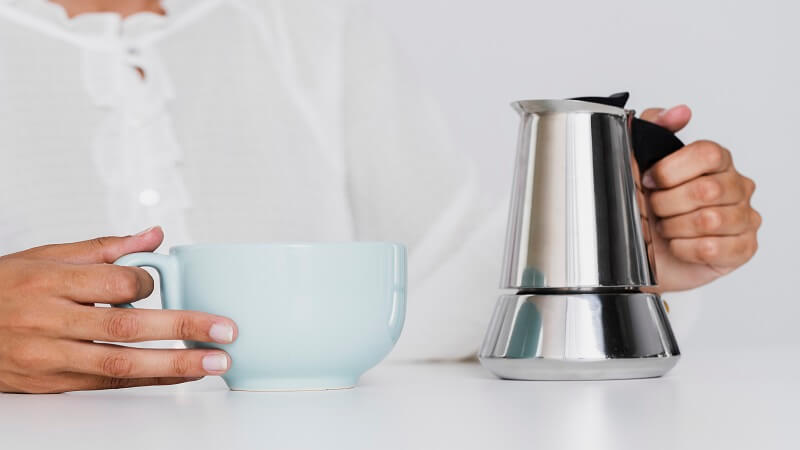If you’re a fan of strong, flavorful coffee but don’t want the hassle or cost of an espresso machine, a Moka pot might be your new best friend. This iconic stovetop brewer, invented in Italy in the 1930s, has stood the test of time for good reason. It’s affordable, compact, and makes a rich, concentrated brew that coffee lovers adore. But with so many alternative models, sizes, and materials, finding the best Moka pot is daunting. Whether you’re an emerging stovetop coffee enthusiast or want to refresh your equipment, this is the definitive guide to assist you in locating the definitive one.
1. Learn How a Moka Pot Works
It would be preferable that we know beforehand how a Moka pot operates prior to proceeding to the options. A standard Moka pot has three parts: the bottom chamber (where water is put), the funnel-shaped middle filter basket (where coffee grounds are put), and the top chamber (where brewed coffee is).
As the water down below gets heated, steam pressure pushes the hot water through the coffee and into the top chamber. And voila? A rich, espresso-style cup of coffee, on your stovetop.
2. Choose the Correct Size
Moka pots have different sizes, typically in terms of “cups.” Keep in mind, though, these are espresso cups — about 1.5 oz (50ml) — not typical mugs.
Here is a handy size chart:
- 1-cup: Suitable for single consumer or individuals requiring just a shot short
- 3-cup: Most used size suitable for individual or two users
- 6-cup: Suitable for two or more users
- 9+ cup: Suitable for family or having guests over
When you use coffee alone usually but occasionally you desire more, you may also wish to possess more than one size so that you can make it appropriate for various situations.
3. Select Between Aluminum or Stainless Steel
Aluminum and stainless steel are the most common materials used to manufacture Moka pots, and both have advantages and disadvantages.
- Aluminum Moka Pots: These are the traditional and commonly less costly They get heated rapidly and effectively, and they give a classic flavor and appearance. Aluminum is more brittle, however — it can’t be placed in the dishwasher, and it will eventually become rusty if not dried thoroughly.
- Stainless Steel Moka Pots: Stronger, dishwasher-safe, and corrosion-resistant. Slightly more expensive, but ideal for those who desire low maintenance, long-term use. They also heat nicely on induction stovetops.
If you’re still unsure what to use, look at your lifestyle: use aluminum if you love tradition and taste, or stainless steel if you prefer low maintenance.
4. Consider Your Stovetop Compatibility
Ensure the Moka pot is induction stovetop safe before you press the “buy” button. The retro aluminum model won’t be unless it has an adapter plate. Stainless steel ones generally will be, though. Read the product description or packaging prior to buying, always.
If you’re shopping around for a stylish and sophisticated moka coffee maker, Maxicoffee carries a well-curated range of high-end brands and models, suitable for any type of coffee enthusiast. From traditional Bialettis to sleek stainless steel ones, you’re sure to find one that suits your requirements as well as your taste.
5. Think Design and Ergonomics
Aside from function, appearance counts — particularly if your Moka pot is going to sit on your kitchen counter. Some of the newer models are available in bold colors or streamlined minimalism. But form isn’t the only thing. Look at the handle and lid knob — they should be heat-resistant and comfortable to grasp. A well-designed spout also equals a smooth, mess-free pour.
6. Ease of Cleaning
One big thing about owning a Moka pot is keeping it in good condition by cleaning it properly. Traditionalists also suggest not using soap on aluminum models to keep the seasoning and flavor intact. Stainless steel models are slightly easier to clean and are usually dishwasher-safe. For low maintenance, stainless steel is probably the way to go.
Whichever you pick, be certain to rinse the pot thoroughly after each use and dry out the components thoroughly so that they won’t clog or rust.
7. Brand Matters
Some manufacturers have perfected the Moka pot over time. The first and one of the best to this day is Bialetti, for instance. Some other manufacturers include Alessi, Cilio, and Ilsa. Although you do pay more money for these manufacturers, quality, reliability, and durability usually are well worth it.
All the same, new market entrants are also coming with new products such as ergonomic grip, induction capacity, or pressure valves that improve maximum safety and performance. Read product descriptions and customer reviews to find out what works best for you.
8. Budget Wisely
Moka pots vary everywhere along the cost scale from under $20 to $100+, depending on brand, construction quality, and design. Just because something is more expensive does not necessarily mean that it is higher-quality coffee, although perhaps more user-friendly or better construction may be the case. Consider use levels and adjust accordingly.
Typically, the most well-rounded quality-wise and for value mid-grade choice for the majority is normally a well-designed model by a reputable manufacturer.
Final Thoughts
The perfect Moka pot is the one that fits your routine, taste, and kitchen setup. Whether you’re drawn to the charm of an aluminum classic or prefer the modern edge of stainless steel, there’s a Moka pot out there that’s just right for you. Window-shop at leisure and don’t be afraid to spend a little more for quality. The quality Moka pot will last a lifetime, and it’ll bring café-quality coffee into your house daily.
